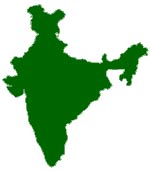Food Tour of India
Diversity of Indian Cuisine

Most Indian cuisine are related by the similar usage of spices and the use of a greater variety of vegetables than many other cuisine. Religious and caste restrictions, weather, geography and the impact of foreigners have affected the eating habits of Indians.
For example, Brahmins (one of the highest orders of caste) are strict vegetarians usually, but in the coastal states of West Bengal and Kerala, they consume a lot of fish. Southern Indians generally speaking, have been orthodox in their tastes, probably because eating meat when it is hot all year round can be difficult. In the North, the weather varies from a scorching heat to a nail-biting cold, with a sprinkling of showers in between. So, the food here is quite rich and heavy. Also, the Mughal influence has resulted in meat-eating habits among many North Indians. Also, a variety of flours are used to make different types of breads like chapathis, rotis, phulkas, puris and naan.
In the arid areas of Rajasthan and Gujarat, a great variety of dals and preserves (achars) are used to substitute the lack of fresh vegetables and fruits. Tamilian food uses a lot of tamarind to impart sourness to a dish, whereas Andhra food can be really chili-hot. It is believed that a hot and spicy curry may be one of the best ways to combat the flu virus! From, ancient times Indian food has been on principle, divided into the Satwik and Rajsik kinds. The former was the food of the higher castes like the Brahmins and was supposed to be more inclined towards spirituality and health. It included vegetables and fruits but, not onions, garlic, root vegetables and mushrooms. The more liberal Rajsik food allowed eating just about anything under the sun, with the exception of beef. The warrior-kings like the Rajputs whose main requirements were strength and power ate this food.
Just as Japanese sushi relies on the freshness of the meat and Chinese food relies on the various sauces to impart the right flavor and taste, Indian food relies on the spices in which it is cooked. Spices have always been considered to be India’s prime commodity. It is interesting to see an Indian cook at work, with a palette of spices, gratuitously sprinkling these powders in exact pinches into the dish in front of him/her. A foreigner can discover the many differences in the foods of various regions only after landing in India, as most of the Indian food available abroad, is the North Indian and Pakistani type. The variation in Indian food from region to region can be quite staggering.
Many Indian dishes require an entire day’s preparation of cutting vegetables, pounding spices on a stone or just sitting patiently by the fire for hours on end. On the other hand, there are simple dishes which are ideal for everyday eating.
Eating from a ‘thali’(a metal plate or banana leaf) is quite common in most parts of India. Both the North Indian and South Indian thali contain small bowls arranged inside the rim of the plate(or leaf), each filled with a different sort of spiced vegetarian food, curd and sweet. At the center of the thali you would find a heap of rice, some puris(wheat bread rolled into small circular shapes and deep-fried in hot oil) or chapathis(wheat bread rolled out into large circular shapes and shallow-fried over a hot ‘tava). Indians wash their hands immediately after and before eating a meal as it is believed that food tastes better when eaten with one’s hands.